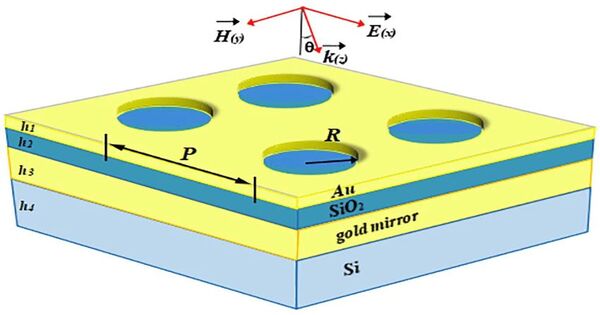Plasmonic metamaterials are manmade materials that have unique optical features due to their interaction with light at the nanoscale. It is a metamaterial that employs surface plasmons to produce optical features not seen in nature. Plasmons are formed by the interaction of light with metal-dielectric compounds. These materials are made up of structured nano-sized elements, such as metal nanoparticles or nanostructures, which allow them to alter light behavior in ways that natural materials cannot.
Under certain conditions, incoming light combines with surface plasmons to form self-sustaining, propagating electromagnetic waves known as surface plasmon polaritons (SPPs). Once launched, the SPPs ripple across the metal-dielectric contact. SPPs can have significantly shorter wavelengths than incoming light.
Plasmonic materials
Plasmonic materials are metals or metal-like materials with negative real permittivity. The most prevalent plasmonic materials are gold and silver. However, several other materials exhibit metal-like optical characteristics in certain wavelength ranges. Several research groups are experimenting with different methods to create plasmonic materials with lower losses and tunable optical characteristics.
The qualities are derived from the metal-dielectric composites’ unusual structure, which includes features smaller than the wavelength of light separated by subwavelength lengths. Light striking such a metamaterial is converted into surface plasmon polaritons, which have a shorter wavelength than the incident light.
Some key characteristics and applications include:
- Subwavelength Light Manipulation: Plasmonic metamaterials can manipulate light at scales smaller than the wavelength of light, allowing for the creation of ultrathin optical components, such as lenses, waveguides, and filters.
- Enhanced Light-Matter Interaction: The strong interaction between light and the surface plasmons in these materials leads to enhanced electromagnetic fields near the surface, enabling applications such as surface-enhanced spectroscopy and enhanced light emission from quantum emitters.
- Tunable Optical Properties: The optical properties of plasmonic metamaterials can be tuned by adjusting the size, shape, composition, and arrangement of the nanostructures, offering control over parameters such as resonance frequency, scattering, and absorption.
- Sensing and Detection: These are employed in a variety of sensing applications, including biosensing, chemical sensing, and environmental monitoring, because of their capacity to detect minor changes in the immediate environment via plasmonic response variations.
- Metamaterial Cloaking: Metamaterials having specialized optical properties can be used to influence the propagation of light waves, resulting in the development of cloaking devices that can make objects invisible to certain wavelengths of light.
Overall, plasmonic metamaterials are a fast-expanding subject at the interface of nanotechnology and photonics, providing unparalleled control over light-matter interactions and allowing for a wide range of novel applications.
















